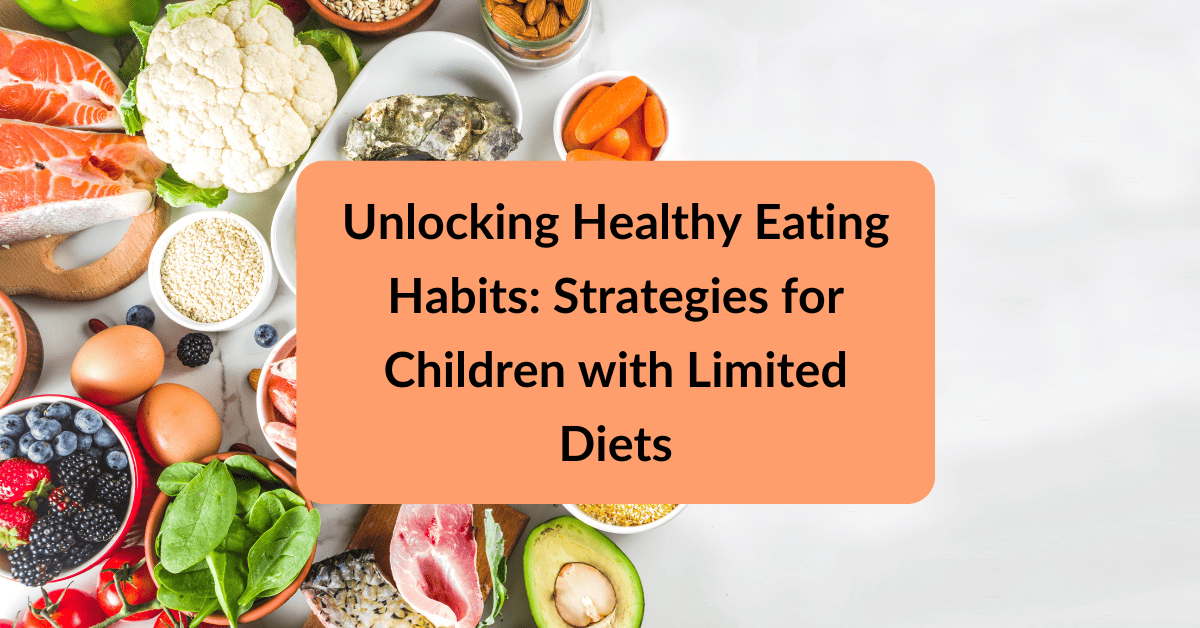Last updated on May 16th, 2024 at 03:28 am
Unlocking Healthy Eating Habits: Strategies for Children with Limited Diets
Encouraging healthy eating habits in children is a universal challenge for many parents.
However, it brings unique complexities when you have a child who has a very limited diet.
This post is an exploration for you, particularly if you have a picky eater and a child on the autism spectrum, seeking both understanding and effective strategies to expand their diet in a way that supports overall health and well-being.
The Importance of Healthy Eating Habits in Children
Nutrition plays a foundational role in childhood development, impacting growth, cognitive function, and overall health. 
However, many children struggle with maintaining a diverse and balanced diet, and this is not simply a matter of being ‘stubborn’ or ‘fussy.’
Understanding the root causes of a child’s limited diet is essential for addressing it effectively.
Factors such as sensory processing issues, where certain textures or flavors become overwhelming, can significantly influence a child’s willingness to try new foods.
Additionally, children with food neophobia, a fear of new foods, often stick to a very narrow selection of what they eat.
Identifying these underlying issues can guide you in adopting more tailored strategies that respect your child’s specific needs and challenges while gradually introducing them to new, healthy eating habits options.
Understanding Limited Diets in Children
When we talk about limited diets in children, we are referring to the behaviors that limit the type or amount of foods eaten.
Whether due to sensory sensitivities, adverse experiences, development factors, or environmental influences, a limited diet can lead to nutritional deficiencies and challenges in ensuring the child’s growth and well-being.
Sensory Sensitivities
Many children, especially those on the spectrum, experience the world through heightened senses, which extend to their experience with food.
Sensory over-responsivity can lead to a limited diet that avoids certain textures, colors, smells, or flavors.
Disclosure: There are affiliate links in this post. If you click the link and buy something, I might get a commission at no additional cost to you! This is what keeps this blog running so consider using these links if you decide to try any of my recommendations.
Developmental Factors
Certain maturational stages in children are associated with changes in eating habits.
The ‘picky eating’ often seen in young kids can, in some cases, be more than just a phase, particularly when it persists through developmental milestones.
Environmental Influences
The immediate family and social environment also play a significant role.
For instance, a child may model the eating behaviors of family members or be influenced by factors such as anxiety or stress during meal times.
Toxicity Factors Contributing to Picky Eating
 Toxicity factors in a child’s environment can also significantly contribute to the development and persistence of picky eating behaviors.
Toxicity factors in a child’s environment can also significantly contribute to the development and persistence of picky eating behaviors.
Exposure to toxins, both from food sources and the environment, can affect a child’s neurodevelopment and digestive health, inadvertently influencing their eating habits.
For example, high levels of pesticides in non-organic fruits and vegetables may cause subtle changes in a child’s taste sensitivity or digestion, making them more reluctant to try or accept certain foods.
Similarly, environmental pollutants, such as heavy metals found in water or certain types of foods, can impact a child’s appetite and metabolism.
Understanding and reducing toxicity risks through choices like organic foods, clean water, and the use of zeolites for consistent detox can help improve children’s limited diets.
Identifying Food Preferences and Aversions
To address a limited diet, it’s essential to identify the specific food preferences and aversions of your child.
By categorizing their eating habits, you can better understand the areas to focus on during your efforts to expand their diet.
Foods Typically Preferred by Picky Eaters
Picky eaters often show a preference for staple ‘comfort’ foods, typically those that are mild in flavor and uniform in texture.
These foods often include items such as plain pasta, white bread, chicken nuggets, and potatoes.
Understanding this preference for simpler, less complex foods can serve as a starting point for gradually incorporating new foods that have similar characteristics but offer more nutritional value.
Foods Often Avoided by Picky Eaters
 New or unfamiliar foods are usually the first to be resisted, whether due to color, texture, or flavor.
New or unfamiliar foods are usually the first to be resisted, whether due to color, texture, or flavor.
This includes many nutrient-dense options that are crucial for a child’s well-rounded diet.
It’s essential to approach these foods with patience and understanding, gradually introducing them in small portions or incorporating them into familiar dishes for a more subtle introduction.
Impact of Limited Diets on Nutritional Health
A restricted diet can result in several nutritional deficiencies, impacting the child’s growth and long-term health.
Identifying these deficiencies and their impact is the first step in the intervention process.
Potential Nutritional Deficiencies in Picky Eaters
Common deficiencies in picky eaters include iron, zinc, and certain vitamins, notably vitamin D and B12.
These are essential for the development of bones, muscles, and cognitive function.
Inadequate intake of these nutrients can lead to issues such as cognitive impairments, anemia, and many other things.
Addressing these deficiencies requires a multi-faceted approach, including dietary adjustments and, in some cases, supplementation.
Raising the variety in a child’s diet not only helps in meeting their nutritional requirements but also in building a resilient foundation for healthy eating habits.
Encouraging the consumption of a balanced diet is so important and can significantly mitigate the risks associated with a low food variety diet.
Strategies for Expanding Your Child’s Diet
Once you have identified the underlying causes and nutritional deficiencies, it’s time to start implementing strategies for expanding your child’s diet.
Here are a few effective approaches you can consider:
Gradual Exposure and Positive Reinforcement
Gradually introducing new foods in small portions and pairing them with familiar options can make them less intimidating for the child. Providing positive reinforcement, such as praise or rewards, when they try new foods can also encourage them to be more open-minded.
Involve Your Child in Meal Preparation
Allowing your child to participate in meal preparation, whether it’s washing vegetables or mixing ingredients, can give them a sense of control and involvement in the process. This can make them more willing to try foods that they have helped prepare.
Make Meal Times Fun and Stress-Free
Stress and anxiety during meal times can significantly impact a child’s willingness to eat. Creating a relaxed and enjoyable environment, such as having family meals together or incorporating fun activities during meals, can help reduce stress and encourage positive associations with food.
Introduction of New Foods
Gradual exposure and creative presentation of new foods can positively influence your child’s acceptance and curiosity about these items. For example, incorporating new vegetables into a pasta dish or blending fruits and vegetables into smoothies can make them more palatable for picky eaters.
Role Modeling Healthy Eating Behaviors
Children are observant, and you can lead by example. When kids see the adults in their lives enjoying a variety of foods, they are more inclined to copy that behavior. This can also include involving the whole family in trying new foods together.
Addressing Specific Food Preferences and Aversions
Understanding and addressing each child’s unique food preferences and aversions is critical in expanding their diet.
It starts with observing and noting the particular foods your child consistently avoids or shows interest in.
Once identified, create a strategy to introduce new, similar foods that might align with their existing preferences but are nutritionally superior.
Similarly, if there’s an aversion to textures, begin with smoother versions of nutrient-dense foods, like pureed vegetables, before moving to more complex textures.
Engagement and patience are key, as is celebrating small wins when new food is successfully introduced.
Health Consequences of Poor Nutrition in Children
 Poor nutrition can lead to a range of health problems, including stunted growth, weakened immune systems, and inadequate brain development.
Poor nutrition can lead to a range of health problems, including stunted growth, weakened immune systems, and inadequate brain development.
Ensuring your child receives balanced nutrition is crucial for their overall health and well-being.
A diet lacking in essential nutrients can hinder physical development, cognitive function, and even emotional regulation.
To combat this, incorporating a variety of fruits, vegetables, whole grains, and lean proteins into your child’s diet can provide the necessary vitamins, minerals, and other nutrients required for healthy growth.
Remember, making small, incremental changes to your child’s diet can lead to significant improvements in their nutritional health over time.
Final Thoughts on Cultivating Healthy Diets in Children
The path to expanding a limited diet for a child, especially a picky eater or one on the autism spectrum, is uniquely challenging but profoundly rewarding.
It requires understanding, patience, and a commitment to exploring new foods in a supportive and nurturing way.
If you are looking for support and resources, check out this Roadmap for Initiating Dietary Changes for Your Child.
By cultivating a positive mealtime environment, seeking professional guidance when needed, and celebrating every small step, you can unlock healthier eating habits that will benefit your child for a lifetime.
Keep in mind that each child is unique, and progress happens bit by bit.
Embrace this fact and enjoy the journey of trying new foods with a positive and resilient attitude.
Additional Resource:
- Check This Out for More Useful Resources
- How to detox your child’s body naturally?
- Why Nutrition plays an essential role in the health and development of all children?
- What is zeolite used for?





0 Comments